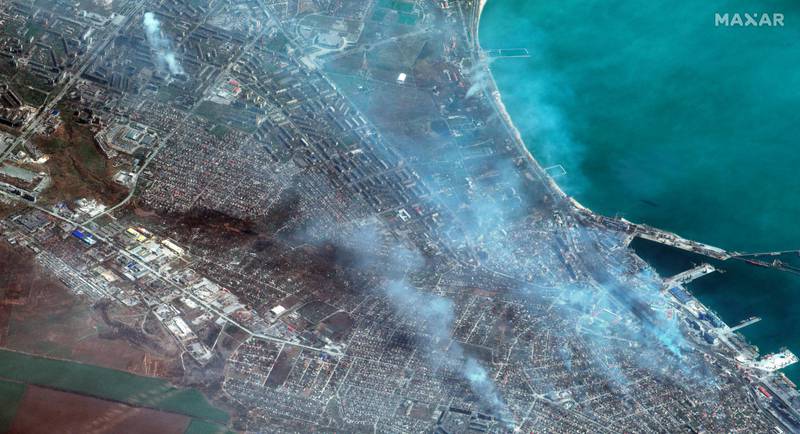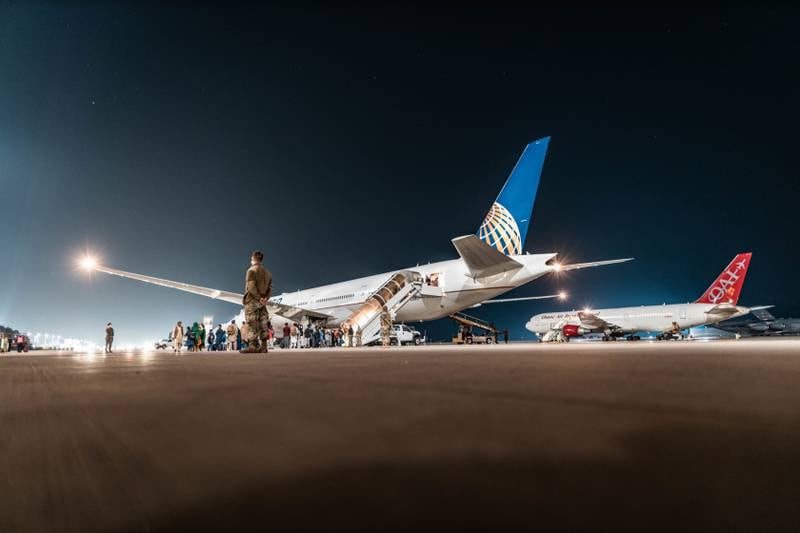WASHINGTON — In August of 2021, U.S. Secretary of Defense Lloyd Austin called on major airlines to augment a military mission to transport evacuees out of Afghanistan following President Biden’s decision to withdraw combat forces from the region.
Leveraging contracts established through the Civil Reserve Air Fleet, the U.S. Department of Defense requested a total of 18 aircraft from six airlines to fly passengers from way stations outside of Kabul to staging bases, allowing the Pentagon to focus on the more dangerous task of evacuating Hamid Karzai International Airport. In the end, commercial airliners flew more than 420 flights to support the operation.
It was only the third time the military activated the program, dubbed the CRAF, since it was created more than 70 years ago to provide extra airlift capacity in times of crisis and conflict. It was first used from August 1990 to May 1991 in support of Operations Desert Shield and Desert Storm and then again from February 2002 to June 2003 during Operation Iraqi Freedom.
RELATED

Participation in the CRAF is voluntary for airlines, who make a portion of their aircraft available for military use through contracts with U.S. Transportation Command. In exchange, the Defense Department prioritizes using those carriers for commercial cargo and passenger transport during peacetime.
For the Pentagon, the program represents a crucial partnership with commercial industry, which it highlighted in an August 2021 statement announcing its decision to activate the air fleet.
“The DoD’s ability to project military forces is inextricably linked to commercial industry,” the department said. “Utilizing commercial partners expands TRANSCOM’s global reach as well as access to valuable commercial intermodal transportation systems.”
With the CRAF and its maritime equivalent — dubbed the National Defense Reserve Fleet — as models for how to take advantage of commercially-owned capacity in times of need, the Space Force is in the early phases of designing its own version, the Commercial Augmentation Space Reserve.
Chief of Space Operations Gen. Chance Saltzman said during a March 15 McAleese and Associates conference in Washington that the Space Force has identified some mission areas within the service where a commercial reserve could play a role, including space domain awareness, satellite communications and intelligence, surveillance and reconnaissance.
The service is thinking through some of the policy, contractual and legal questions around how to employ commercial services during a conflict, he said. It’s also getting input from companies on how the CRAF model could be best adapted for the space domain.
“The real key to success for making sure that commercial augmentation is available throughout the spectrum of a conflict is that we talk early upfront and we pre-plan and establish expectations,” Saltzman said.
A new model for space
While the air and maritime reserve fleets offer a helpful reference point for the Space Force as it designs a program of its own, some industry and former government officials said neither provides a perfect model.
David Gauthier, chief strategy officer at space consultancy GEOX and the former director of commercial operations for the National Geospatial Intelligence Agency said he’s interested in the concept, but it’s unlikely the Space Force’s program would operate like existing reserve fleets. CRAF, for example, can call on hundreds of aircraft in an emergency. The NDRF provides a reserve of about 100 mostly military-useful cargo and tankers, ready to aid national defense.
The Space Force hasn’t settled on a design for its Commercial Augmentation Space Reserve. Officials from Space Systems Command, the service’s acquisition arm, met with industry in early February in Washington to discuss the concept and are planning more meetings in the coming months.

Gauthier, who attended the February meeting, said there are unique questions about risk for a space reserve. While the military can use commercial aircraft or a cargo ship to augment operations during a conflict without inserting them into a warzone, that boundary doesn’t necessarily exist in space.
“In space conflicts, the threat environment is always there, all the time, everywhere,” he said during a March 14 panel at the Satellite Conference in Washington. “The hardware, the satellites that are commercially owned and operated are actually continuously at risk in that environment. So, the second they announce that they’re working for the military and doing business there, they’re under constant threat.”
That risk calculation is tricky for commercial operators, Gauthier said, and raises questions about how the government will protect non-DoD assets that become targets of a foreign adversary. The Pentagon is exploring the possibility of providing compensation for commercial systems in such scenarios but hasn’t developed a formal policy.
“How do you either protect those commercial satellites and their business upside or downside and how do you incentivize them to support military needs?” he said. “It’s not as easy as just paying a little bit of money. There’s a lot more that has to go into that over time to ensure that companies are willing to take that risk.”
Incentives for satellite operators
Aidan Poling, a research analyst at the Mitchell Institute for Aerospace Studies, wrote in a Feb. 23 issue paper published by The Atlantic Council that the government should consider a “preferential contract award system for private-sector participants” in the Commercial Augmentation Space Reserve and established fixed payment structures.
“These steps would create financial carrots for satellite operators while simultaneously lowering risk, incentivizing them to participate,” he said.
Along with commercial satellite protection and indemnification, the government also has trust issues to sort through when it comes to relying on commercial providers for wartime services, Craig Miller, president of government systems at Viasat, told C4ISRNET.
“We think we are very trustworthy, and we’re very interested in being the very best provider we can be and always honoring our contracts. But there’s the sort of whispered notion that commercial companies could be manipulated by foreign actors,” he said in a March 15 interview. “If a foreign actor threatens to do something terrible to a commercial company . . . what guarantee does the U.S. government have that the commercial actor might not buckle to that pressure?”
It’s a complicated problem, Miller noted, but one approach to addressing it could be for companies to “hand over the keys” of whatever piece of the satellite network the military needs and allow them to operate it in a time of crisis.
RELATED

“If the government basically has the ability to make business decisions for you in that case, they have to make it worth your while,” he said. “We can’t do that without being made whole, which means it’s going to cost the government money to do that.”
Miller also pointed to differences in how commercial airlines and, for example, modern commercial satellite communication providers shift capacity among their customers. While the CRAF model depends on airlines making a portion of their fleet available to the military, today’s satellite networks can expand capacity fairly seamlessly.
That means that if the Space Force wanted to reserve commercial SATCOM capabilities for a crisis, it could arrange that in advance and companies could transfer that capacity in real time.
“That surge capability, that crisis capability, that’s available without the government having to essentially take possession of the system,” Miller said. “Maybe you don’t pay for it all the time, but you have it on retainer and you have the flexibility to scale up.”
Courtney Albon is C4ISRNET’s space and emerging technology reporter. She has covered the U.S. military since 2012, with a focus on the Air Force and Space Force. She has reported on some of the Defense Department’s most significant acquisition, budget and policy challenges.








